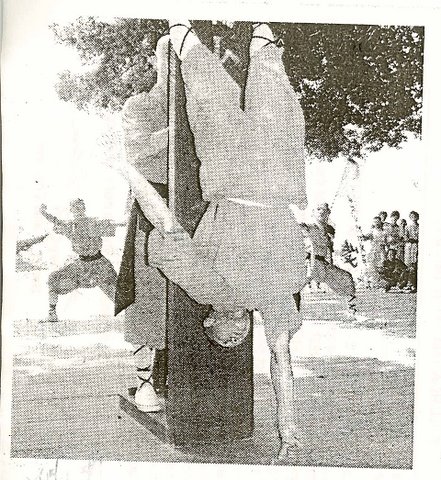The first comments have come in as Secrets of the Handstand Quickstart packages have arrived. Here’s a great one:
I really liked your quick start guide. I have been hand balancing for a while now and can perform a half dozen variations of the head stand as well as hold a gymnastics style hand stand. I am currently working the start and stop method to learn how to walk on my hands.
But one thing that seemed to always elude me was the tiger stand. I practiced this move a lot against the wall but after weeks of practice I could never consistently find that “sweet spot.” After seeing you do a tiger stand in the video, that same day, when I went to the gym it took me 2 tries and now I can easily and consistently find the “sweet spot” hold the tiger stand. I must of unconsciously picked up something when I watched you kick up and hold the tiger stand.
Another thing I learned from the video is that the kick up is way more important than I originally thought. I was basically muscling the handstand back from my kick up (which was way to hard). I could do it but it took a lot of energy. For the past few days I just worked my kick up over and over again. After only 2 days of working my kick up I am hitting my “sweet spot” 8 times out of 10 when before I was only hitting it 1 or 2 times out of 10 and the other hand stand attempts I was muscling back from an over anxious kick up.
So, your videos were helpful to even someone like myself who has been practicing handstands successfully for several weeks. Just seeing someone else do the move and step me through the process, which is something I have read about and knew all ready, helped me greatly.
Thanks a lot,
Ricky
aka “Nifty”
I’m glad to see you got a lot out of it ‘Nifty’ and you aren’t the only one.
If you haven’t checked it out, you might’ve been under the impression that it was only for beginner’s.
And you’d be right…partially.
That guide is to get beginner’s up into a free standing handstand as soon as possible. I’ve spent much time and effort helping the beginner’s because, well there are more of them, and its harder than anything to get started.
But its just the start. The launching pad for a program that will help out all but the very best in this art.
And of course that is the Acrobat Accelerator program. In the monthly DVD and newsletter I will delve into various hand balancing topics in more depth.
This month the first issue covered everything you could possibly want to know about kicking-up into a handstand. I share my story of holding a handstand for 30 seconds for the first time ever but then relate the fact that I was able to hold only about one out of every ten handstands.
The kick-up is of utmost importance to really dial in if you want consistency in your handstand ability. Even if you don’t get this DVD you need to understand this concept.
But once again that’s just the beginning.
From there I cover advanced variations that will make you even better. When you learn to control your body from any angle that it comes up in your hand balancing ability shoots through the roof.
The variations I cover in detail are opposite leg kick-ups, two leg kick-ups, raised kick-ups, and the cartwheel stall. Are you able to do all of them?
There’s about 30 issues left. If you want in on a trial membership just get your free order (except shipping) to try it out.
If you miss out, it’ll be your last chance to get the April issue.
Good Luck and Good Hand Balancing,
Logan Christopher
P.S. Next week I’ll post some new videos up on the blog on some moves closely related but outside of hand balancing which I am putting together right now. Stay tuned.








